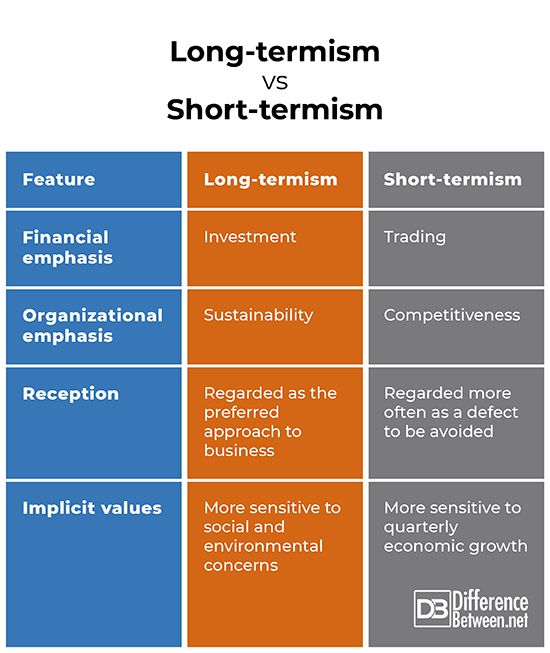Difference Between Long-Termism and Short-Termism

What is Long-Termism?
In business, long-termism refers to a strategy where corporations prioritize long-term investments over short-term gains and trading.
Corporations practice long-termism in a variety of ways. One way is to prioritize factors that are unique to a particular industry, such as organizational factors or employment. Another way is to focus on corporate policies which address long-term sustainability issues related to the environment, governance, and social concerns.
Environmental, social, and governance (ESG) concerns are evaluated together using the ESG criteria. Environmental criteria include waste management, the company’s energy budget, pollution, and environmental risk management. Social criteria involve relationships with other businesses, employees, and the wider community. This includes how the company is treating its employees and whether its policies reflect a high regard for their health and safety. Social criteria also evaluate whether the company is working with suppliers who share their overall values. Furthermore, another important social criterion is the company’s involvement in its local community. Governance concerns involve the company’s leadership practices.
Another way that companies focus on the long term is by investing in research and development (R&D). Investment in research and development is inherently an investment in the future of a company. It may cost the company in the present, but the results of research and development may result in significant growth later. There are many historical examples of this principle, for example, research into electromagnetic radiation by James Clerk Maxwell in the 19th century. His interest in flowing electrons did not seem very important at the time, but later led to the widespread use of electricity which helped to create the modern world.
Another example of the value of investment in R&D might be rocketry research in the early 20th century. Few people saw the value in rockets, let alone rockets that could go into outer space, at first, but government investments in rocketry in the United States and other countries transformed communication, defense, terrestrial remote sensing, and space science due to the development of powerful launch vehicles as well as satellites and interplanetary spacecraft.

What is Short-Termism?
Short-termism has been used to describe the tendency within companies and firms to focus on short-term or quarterly gains and trading over long-term investments which may or may not generate short-term profit. Short-termism has also been called “quarterly capitalism” because of the tendency for companies to focus on quarterly growth.
It could be argued that short-termism has some advantages since it allows a company to stay competitive in the near-term. In order to stay competitive, companies must be able to make enough to keep up with competitor firms and to attract investors. Falling behind in the short-term can discourage investors which can have long-term consequences on a company’s future growth. On the other hand, not focusing enough on the long-term can leave a company unprepared for the future.
It has been suggested that one factor encouraging short-termism might be the short tenures of CEOs, who hold office for about 4 years on average when it used to be 8 years in previous decades. Since they are only in charge of the direction of a company for a short time, this may encourage short-term thinking with respect to the future. Furthermore, hiring CEOs from outside of a company or hiring a CEO who does not have domain expertise may also shift away from long-term goals because of a change in priorities.
Critics of short-termism say that this way of thinking has encouraged companies to not invest in long-term goals towards sustainability with respect to environmental and social concerns. Critics also argue that short-termism has led to a decline in innovation due to lack of investment in R&D. Critics also say that short-termism is causing companies to only think of immediate profits and not the consequences of their actions for the long-term. Defenders of the short-term approach could dispute the evidence of a decline in investment in R&D or employment due to a short-term focus. They might also argue that a focus on short-term gains keeps a company from losing its competitiveness.
Similarities between long-termism and short-termism
Long-termism and short-termism are both terms used in business for strategies that companies use to increase the growth of their organizations.
Differences between long-termism and short-termism
Although there are some similarities, there are important differences. These include the following.
- Long-termism emphasizes investment, whereas short-termism emphasizes trading.
- Long-termism focuses on sustainability, whereas short-termism emphasizes competitiveness.
- Long-termism is considered by many to be an acceptable approach to business, whereas short-termism tends to be treated more as a defect, rather than as a legitimate strategy.
- Long-termism favors broader social and environmental concerns, whereas short-termism favors an emphasis on quarterly economic growth.
Long-termism vs. short-termism

Summary of Long-termism vs. short-termism
Long-termism is a strategy in business that prioritizes investment in the long-term growth and sustainability of a company. This includes a company’s investment in R&D in order to encourage future innovation. This also includes company policies related to energy usage and waste management to ensure that a company remains environmentally sustainable and a company’s relationship with its employees, other businesses, and its community. Long-termism also has implications for corporate governance. Short-termism is a strategy in business that focuses on short-term or quarterly growth. Short-termism has been frequently criticized as slowing down innovation and corporate response to environmental and social concerns, but its defenders could highlight the importance of success in quarterly growth for a company to remain competitive and attract investors. The reasons suggested for the prevalence of short-termism include the short length of the tenures of most CEOs and hiring a CEO from outside the company or without the necessary domain expertise. Short-termism and long-termism are both strategies interested in ensuring the welfare and survival of a company. Nonetheless, they differ in important ways. Long-termism emphasizes investment, is more sensitive to social and environmental concerns, emphasizes sustainability, and is generally recommended by economic and financial experts. Short-termism emphasizes trading, is more sensitive to quarterly economic growth, emphasizes competitiveness, and is generally seen as flaw or defect rather than a legitimate strategy.
- Difference Between Environmental Performance Index and Development - November 24, 2023
- Difference Between Environmental Intervention and Development - November 8, 2023
- Difference Between Eco Efficiency and Eco Effectiveness - September 18, 2023
Search DifferenceBetween.net :
Leave a Response
References :
[0]Burrows, William E. This new ocean: The story of the first space age. Modern library, 2010.
[1]Casey, Caitlin. “Short Termism in Financial Markets.” United Nations Global Impact,
[2]https://www.unglobalcompact.org/take-action/action/long-term. Accessed 30 Jun. 2020.
[3]“James Clerk Maxwell (1831-1879).” Scottish Science Hall of Fame, N.D., https://digital.nls.uk/scientists/biographies/james-clerk-maxwell/discoveries.html
[4]Knott, Anne Marie. “The Real Reasons Companies Are So Focused on the Short Term.” Harvard Business Review, 13 Dec. 2017, https://hbr.org/2017/12/the-real-reasons-companies-are-so-focused-on-the-short-term. Accessed 30 June 2020.
[5]“Long-Termism Versus Short-Termism: Time for the Pendulum to Shift?” Institutional Investor, 13 Jun. 2016, https://www.institutionalinvestor.com/article/b14z9mxp09dnn5/long-termism-versus-short-termism-time-for-the-pendulum-to-shift.
[6]Lubber, Mindy. “Ending Quarterly Capitalism.” Forbes, 21 Feb. 2012, https://www.forbes.com/sites/mindylubber/2012/02/21/ending-quarterly-capitalism/#342c83d477a6. Accessed 30 June 2020.
[7]“Short-Termism.” CFA Institute, N.D., https://www.cfainstitute.org/en/advocacy/issues/short-termism.
[8]“The Short Termism Thesis: Dogma vs. Reality.” Harvard Law School Forum on Corporate Governance, 18 Mar. 2019, https://corpgov.law.harvard.edu/2019/03/18/the-short-termism-thesis-dogma-vs-reality/
[9]Image credit: https://live.staticflickr.com/5572/15108509530_9d3f6f9f83_b.jpg
[10]Image credit: https://cdn.pixabay.com/photo/2019/09/19/06/04/in-the-short-term-4488315_960_720.jpg
